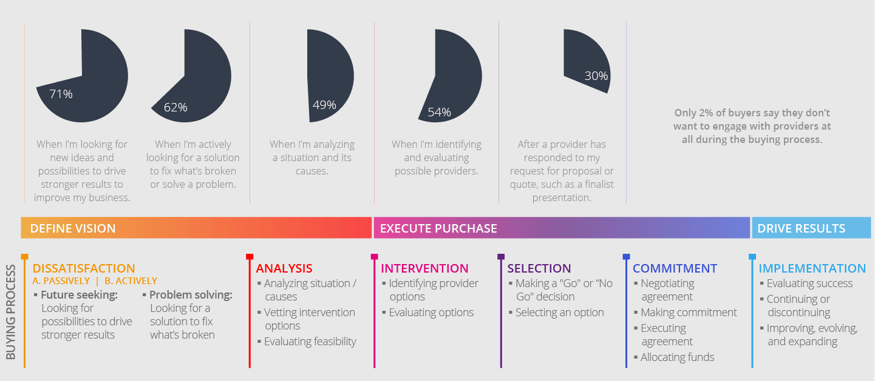There are 2 stats that are cited in sales articles all the time:
- 57% of the purchase decision is made before a customer calls a supplier
- 67% of the buying journey is now done digitally
The question, however, is so what?
Sellers and sales leaders often interpret this to mean that buyers don't want to hear from sellers.
This is far from the truth.
Through the RAIN Group Center for Sales Research, we studied 488 B2B buyers who represent $4.2 billion in purchasing power across 25 industries. When we asked, "When do you want to hear from sellers?" here's what we found:
- 71% of buyers want to talk to sellers when they're looking for new ideas and possibilities to drive stronger business results
- 62% of buyers want to talk to sellers when they're actively looking for a solution to fix what's broken or to solve a problem

This does not sound like buyers don't want to hear from sellers, which is why this is myth #1 in our white paper, 5 Sales Prospecting Myths Debunked.
The 2 Buying Mindsets: When Buyers Want to Talk to Sellers
In B2B selling, buyers want to hear from sellers during the Define Vision phase of the buying process. Early in this phase, what we call "Dissatisfaction," they are in one of two buying mindsets:
- Future-seeking: Buyers are looking for possibilities to drive stronger results.
- Problem-solving: Buyers are looking for a solution to fix what's broken.
Sellers assume buyers in problem-solving mode know how they want to fix things.
They don't.
Often buyers are frustrated with what they have. Processes take too long. Costs are too high. Turnover is too high. Technologies aren't adopted or used. They want to solve these problems, but they only have so much time to dig into them.
If a seller has ideas on what they might do in these areas, the buyer will be open to listening.
But problems only represent one reason why buyers buy. The other buying mode—future-seeking—is just as powerful.
Buyers in future-seeking mode are looking for ways to make their companies better, grow, and improve. They are making investments for the future and generally do not have a set-in-stone vision for what that looks like.
These buyers want your ideas and to learn possibilities. In fact, 71% buyers of want to hear from you at this point in the buying process.
You're probably sitting there thinking this is the complete opposite of what you've been told!
But it's true. Buyers want to talk to you, and they want to talk to you early!
Deepen Buyer Needs
We asked the buyers what factors influence their overall purchase decision. A whopping 92% of buyers said they'd be influenced to buy from sellers who "deepen my understanding of needs."
The keyword here is deepen. In your conversations early in the process, it's critical that you not only demonstrate you understand buyer needs, but also deepen them.
Today's buyers may be more educated and fluent about you and your competitors' offerings. They may do research on their own, furthering their buying journey online. But buyers still want sellers who can help them think about their needs in new ways, who push them outside of the box, who reshape and redefine their needs, and who provide insight on what they've seen work and not work.
The sellers who take to a consultative selling approach—those who shape and define buyer needs, add value to the conversation through sharing new ideas and insights, and collaborate with buyers—are the ones who come out on top.
Talk to Your Buyers Early
Forget what you may been told in the past. Get in front of your buyers and talk to them early.
Sellers who:
- Master consultative selling
- Deepen buyers' understanding of their needs
- Reach out and connect with buyers early in the buying process
will greatly increase their odds of winning and becoming a Top Performer in sales.







